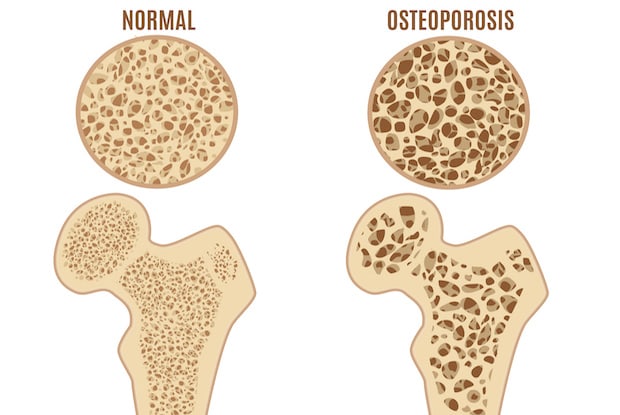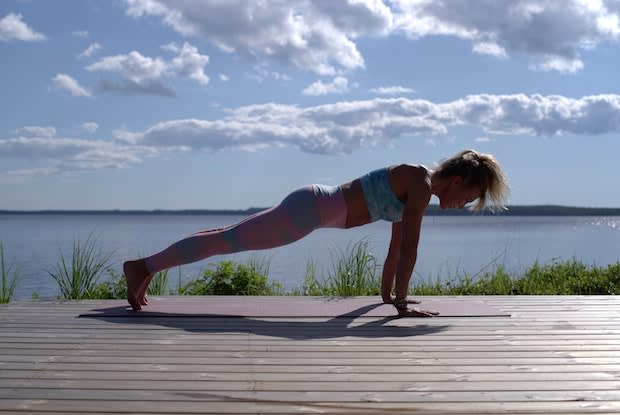Table of contents
Osteoporosis info
Osteoporosis is a disease that weakens bones. Osteoporosis means “porous bone.” Having softer bones can lead to an increase in bone fractures as well as a loss of bone mass. Osteoporosis is a tough disease because the initial stages often occur without any symptoms or pain. There are over 10 million Americans with osteoporosis, and 80% of those patients are women. The patient is usually unaware that they are experiencing osteoporosis unless they experience a breakage or undergo a bone density test. Medications like Premarin can be beneficial in preventing symptoms of osteoporosis. [1]
How does it occur?
Living tissue makes up the bones of the body. The outer layer of the bone is made of dense cortical bone and protects the sponge-like trabecular bone inside. This sponge-like bone has small holes, and when osteoporosis occurs, these holes grow bigger and bigger. These holes then weaken the internal structure of the bone.
Up until the age of 30, the body creates more bone tissue than it loses, but this changes as you grow older. As you grow older, the bones begin to breakdown. The breakdown of bone begins to outpace bone growth, so the loss of bone mass begins to occur. The continuation of this process leads to osteoporosis. [2]

Who is at risk?
This illness is more prevalent in women over the age of 50. Breaking a bone at any time is not a pleasant experience, but those with osteoporosis are at a higher risk of experiencing multiple bone breakages in their lifetime. Women have lighter and thinner bones than men, which puts them at a higher risk. Women also tend to have a longer life span than men, so the chance of osteoporosis steadily goes up with age.
a. Menopausal women
Menopausal women are most often affected by osteoporosis. This is due to the direct link between estrogen and the skeletal system. Estrogen plays a principal role in bone growth, and when menopause hits, this hormone starts to deplete. As the ovaries age and release fewer hormones, the body can no longer regulate estrogen levels.
This estrogen deficiency spurs on the process of osteoclastic bone resorption. Osteoclasts are the cells that break down tissue in bones. This process ramps up significantly 3-5 years after menopause occurs. Estrogen regulates bone homeostasis, so without this vital hormone, osteoporosis can begin in a woman’s body. Approximately one in two women over 50 years old will break a bone because of this disease. [3]
b. Younger women
Loss of bone mass is most common in menopausal women, but it can occur before the age of 45 as well. Early menopause can lead to a bone loss earlier in life. Women who experience prolonged periods, low hormone levels, or have infrequent periods are at a higher risk for loss of bone mass. When young women show signs of osteoporosis, it is most likely due to a pre-existing medical condition that causes bone loss. This is called secondary osteoporosis. [1]
c. Men
Osteoporosis is often associated with females, but men can also be affected. Like women, a man’s risk of osteoporosis goes up significantly after the age of 50. At least one in four men will break a bone from osteoporosis in the United States. [4]
This disease in men is not linked to low estrogen and thinner bones but general aging. Aging takes a toll on all bodies, regardless of sex, but a man’s rate of bone loss is equal to that of a woman by age 65. [5]
Signs and symptoms
Osteoporosis is known as the “silent disease” because most people do not realize they have it until they experience a bone fracture. You can detect osteoporosis in the early stages, but it is difficult. The few early symptoms of osteoporosis can include:
Receding gums: If the jaw is losing bone, your gums can begin to recede. If you notice this occurring and think you are at risk for bone mass loss, you can ask your doctor to screen your jaw for loss of bone tissue.
Brittle fingernails: Strong nails are usually a good indication of robust bone health. If your nails suddenly become weak and brittle, this may indicate the beginnings of loss of bone mass. Several activities can lead to brittle nails, so consult your doctor with any concerns.
Weaker grip strength: Lower grip strength can begin to occur if the bone tissue is deteriorating. Researchers have found that low handgrip strength is linked to low bone mineral density.

It is unlikely that a person will suspect osteoporosis with the symptoms listed above. More severe symptoms often signify the loss of bone tissue. These symptoms often include:
Back or neck pain: Osteoporosis often leads to complications like compression fractures of the spine. This occurs when the vertebrae collapse and pinch nerves, which then sends radiating pain from the spinal cord.
Stooped posture: When the spine starts to collapse, a kyphosis or curving of the spine can occur. This can also cause back and neck pain. This condition may also affect breathing due to pressure on the airway.
Loss of height: When the spine curves, the body loses vertical height. If you notice that you are shorter than you remember, you should consult your doctor.
Fracture: When the bones become porous, the risk of fracture increases significantly. Most people do not know if they have osteoporosis until they break a wrist or a bone during a minor movement like stepping off a curb. Sometimes even a strong cough or sneeze can cause a fracture. [6]
Treatment
For menopausal women, osteoporosis may appear because of an imbalance of hormones like estrogen. Estrogen replacement medications like Premarin can help regulate the hormones within your body. Estrogen maintains the homeostasis of bones, so the proper balance will help prevent bones from becoming porous. Osteoporosis can be hard to treat because of its late detection, but some medications can be taken in order to prevent further bone tissue loss:
Bisphosphonates: Bisphosphonates are the class of drugs most commonly prescribed. Bisphosphonates inhibit loss of bone density and reduce the chance of fracture. Boniva and Fosamax are two popular options for this type of medication.
Denosumab: This newer type of medication reduces the risk of fracture in both men and women. This can be an alternative to bisphosphonates for those reduced kidney function because Denosumabs are easier for the body to absorb. This drug and bisphosphonates do not re-grow bone but prevent the bone from deteriorating further.
Teriparatide: Both men and women also take this drug. It may be best for those with very low bone density and those who have already had fractures. This drug has the potential to rebuild bone.
Abaloparatide: This drug also has the potential to rebuild bone for those with osteoporosis. It has a similar effect to teriparatide, but may cause an excess of calcium in the body. [7]

Recipe for bone health
Osteoporosis usually occurs later in life, but you can take care of your bones from a young age. If you have a healthy skeletal system before reaching middle age or menopause, the effect of osteoporosis may be less severe. The steps below may protect you against severe osteoporosis.
Exercise: An adequate amount of activity makes bones and muscles stronger, which helps prevent bone loss. If you participate in weight-bearing exercises three or four times a week, bone breakage in the future may be prevented. Strength and balance exercises also help you avoid falls.
Calcium: Consuming enough calcium throughout your life helps keep bones strong. It is recommended for adults to consume 1,000 mg of calcium each day. Milk, dairy products, leafy vegetables, oranges, and salmon are good sources of calcium.
Supplements: If you cannot eat enough calcium-rich foods, you can take calcium carbonate and calcium citrate tablets. It is advised not to take more than 2,000 mg of calcium a day because it can increase your chance of developing kidney stones.
Vitamin D: The body uses vitamin D to absorb calcium. The body usually produces enough vitamin D with 20 minutes outside in the sun. You can also get vitamin D from eggs, fatty fish, and vitamin D milk. [8]
Bone Density Test
Once you or your doctor suspect a loss of bone mass, you will most likely do a bone density test. This test shows the amount of bone a person has in their spine, hips, and other bones. This test uses x-rays to measure how many grams of calcium and bone minerals are packed into a segment of bone. If the mineral content is high, then the bones are strong.
These tests are recommended for women in their 50’s, but there are some exceptions. If a younger man or woman experiences several bone breakages unexpectedly, then a bone density test may be done to determine the cause. These tests are fast, painless, and no preparation is needed. [9]
The content in this article is intended for informational purposes only. This website does not provide medical advice. In all circumstances, you should always seek the advice of your physician and/or other qualified health professionals(s) for drug, medical condition, or treatment advice. The content provided on this website is not a substitute for professional medical advice, diagnosis or treatment.
